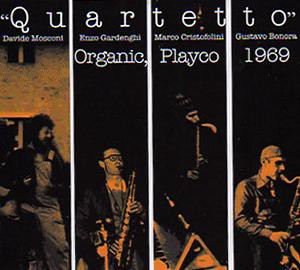QUARTETTO - Organic, Playco 1969
Couldn't load pickup availability
The stable Quartetto that pianist Davide Mosconi, saxophonist Enzo Gardenghi, percussionist Marco Cristofolini, and cellist and violinist Gustavo Bonora brought to life beginning in the late 60s constituted the core of what would, in the early years of the next decade, become the larger improvising ensemble NADMA. The group was also an elegant and accomplished expression of the musical objectives of its members. The rich yields that Davide Mosconi cultivated from his exploration of improvisation and the visionary creativity that revealed influences from parallel planes throughout his oeuvre originated in his formative years. In the life story of Mosconi before the formation of the Quartetto, it emerges that his first musical affirmations arose as he was completing his studies as a photographer. Mosconi furthered his training as a photographer in New York from 1964-1968, including stints as assistant to Richard Avedon and Hiro. Prior to his definitive return to Italy, he spent 1968 in Mexico, a lengthy visit documented splendidly in his photographs. During his stay there, he may have been the first European musician to meet Conlon Nancarrow and encounter his music. From Nancarrow, Mosconi learned the workings of the Ampico player piano. Only much later indeed, in the early 80s, when György Ligeti championed his works, was this now-legendary American composer rediscovered internationally. The Quartetto represented, at last, a solid foundation with which Davide Mosconi succeeded in realizing his own notion of improvisation, aided by musicians who shared his ideal of a continuous, fluid music and thus of a pliable expression that superseded the limits of existential consciousness. In 1968-1969, the group launched an uninterrupted series of private events, studio sessions and live concerts at venues that ranged from offhand happenings to alternative clubs to concert halls. It is possible to reconstruct rather faithfully the activities of Davide Mosconis Quartetto due to a vast amount of material documentation and a conspicuous number of archive recordings. The first recording sessions date from February 14, 1968, and from April of this same year, both made at the Playco studio in Milan and both featuring the lineup of Davide Mosconi, Marco Cristofolini and Enzo Gardenghi, with the additional presence of bassist Giorgio Buratti for the February recordings. The majority of these early Playco recordings, however, date from various months of 1969 until October, after the group solidified its roster with Gustavo Bonora. In several reel tapes dating back to this era, the collective name is often given not as Quartetto, but, alternately, as Organic or Organic Orchestra, designations that foreshadow the Natural Arkestra moniker later associated with NADMA. If one excludes the live recordings from the Auditorium San Fedele and Circolo Lepetit concerts of November and December 1969, the best evidence of the musical art of the Quartetto is found on the reel labeled Organic 1969 Playco, heard in its entirety on the present CD. Examination of the various tapes that document the Playco sessions of 1969 show that this reel is the only one with any consistent identification of the titles of individual tracks, as well as the only one to show signs of careful editing, perhaps intended use as a demo. There are tracks that focus concretely on timbral resources and instrumental gesture (Tubi sonori in scale and Disturbi di violino) and pieces that have decidedly parodistic moments (Parodia della festa and the diptych of Avanti! Para bab-É and Bab-É -fui-p-É ). At least two classics of the Quartetto playlist are also to be found: the opener Fattoria degli animali, whose title manifestly evokes George Orwells dystopic novel, with its onomatopoeic sounds at the onset; and Pugno chiuso, the last of the pieces to be recorded and the one which Gustavo Bonora later called the purest emblem of the musical art of the Quartetto. This latter work is a perfect example of an enragé performance praxis that was then unparalleled in the Italian improvised music scene. The albums sign-off does not stem from the same sessions. It is instead an edited extract from the Circolo Lepetit concert of December 1, 1969, and as such is a most effective taste of the informal and symbiotic potency that distinguished the live Quartetto experience: the merging of individual instruments into a unified whole. This CD is included in a beautiful digipack full-color sleeve with photos and liner notes. Also included is a 12-page booklet with an essay titled Before NADMA: Davide Mosconi and the Quartetto by Gabriele Bonomo as well as the testimonies by Enzo Gardenghi and Gustavo Bonora. -Alga Marghen


